Summary of the Eighth Fundamental Traffic Safety Program
- Japanese
- English
Subtitle
Achieving a society with no traffic accidents
Term
Five years from FY2006 to FY2010
Basic Principles
1. Achieving a Society with No Traffic Accidents
- In order to build a truly prosperous and vibrant society, it is crucial, as a prerequisite, to ensure the safety and security of the people. Securing traffic safety is also an important element to meet the prerequisite.
- In light of the significant social and economic losses arising from traffic accidents, we should aim to ultimately achieve a society with no traffic accidents under the principle of respecting human life.
2. The principle of people first for traffic safety policy
- A civilized society must show consideration and kindness to the weak.
- In terms of traffic, it is necessary to further secure the safety of pedestrians, who are vulnerable in relation to cars, as well as the safety of those especially vulnerable, such as the elderly, the disabled, and children, when they use any type of transportation.
- Following this basic principle of people first for traffic safety policy, we should implement every possible measure.
3. Basic approach to traffic safety measures
- This program sets numerical objectives to be attained within the term of the program, and clarifies the measures that should be taken for achieving these objectives for the following respective traffic sectors: (i) road traffic; (ii) railway traffic; (iii) traffic at railway crossings; (iv) maritime traffic; and (v) air traffic.
- Specifically, with respect to the three components of traffic society, namely, (a) people as a component of traffic society, (b) means of transportation including vehicles, vessels, and aircraft, and (c) the traffic environment that serves as the platform of their activity, and while giving consideration to their mutual relationship, the government shall vigorously promote these measures.
- In road traffic, in particular, it would be significant to further promote people first traffic safety measures for school routes, community roads, and thoroughfares in urban areas, such as actively developing pedestrian walkways.
- When implementing the traffic safety measures, the government shall flexibly adapt these measures to changes in social conditions such as the declining birthrates and aging population and the globalization, as well as to changes in traffic accidents. It shall also incorporate considerations on disaster prevention against earthquakes and tsunamis.
- The government shall drive forward traffic safety activities involving citizens’ participation and collaboration by creating a system in which citizens can participate in traffic safety measures of the national and local government from the planning phase onward, encouraging citizens’ independent efforts to thoroughly check the road traffic environment, and promoting community efforts that appropriately take into account the characteristics of each locality.
4. Measures against human errors in public transportation
The fatal derailment of the Fukuchiyama Line (West Japan Railway) that occurred in 2005 had a great impact on Japanese society. In all public transport sectors of land, maritime, and air transport, all those engaged in traffic administration and transportation services must recognize anew that securing safety is their top priority task, and review ongoing traffic safety measures as well as their own efforts for traffic safety. In this context, we should not merely attribute human errors to individuals. In order to find effective countermeasures, we should find the true culprit behind such errors and make effort to strengthen accident prevention measures from the perspective of improving the corporate structure of transport business and the entire transportation system.
Road Traffic Safety
1. Achieving a Society with No Traffic Accidents
- Under the principle of respecting human life, we should aim to ultimately achieve a society with no traffic accidents.
- In addition to enhanced efforts for the further decrease of fatalities, it is also necessary to be vigorously committed to the reduction of traffic accidents.
- The ratio of pedestrians to total road traffic fatalities is larger in Japan than in the United States and European countries. Therefore, it is especially important to secure the safety of pedestrians under the principle of people first in road traffic policy by developing pedestrian walkways and other measures.
- Since traffic safety is closely related to the conditions characteristic to local communities, it is also crucial to encourage regional efforts, while taking into account the specific traffic conditions in each community. In this process, local governments can and should play a significant role in developing traffic safety systems and measures suitable to each community.
- Based on this premise, all parties in the community, e.g. the government, schools, homes, workplaces, organizations, and companies, should reinforce cooperation among them while bearing their own roles. It will be particularly effective if citizens actively participate and collaborate in various traffic safety activities in diverse ways at each phase from planning to implementation, and review.
- In particular, the participation and collaboration of people who have been injured or have lost their families in traffic accidents is of great importance, because they themselves have experienced and understood what great misery a traffic accident can cause.
- In the process of promoting community efforts, it is also an effective way to regard traffic safety as a key factor to achieve community safety, in addition to crime prevention and disaster prevention.
2. Objectives Set for Road Traffic Safety
(1) Current status and outlook for road traffic accidents
- The annual number of traffic accident fatalities in Japan where people died within 24 hours of an accident hit a peak of 16,765 in 1970, and then started to steadily decrease in the next year, dropping by almost half to 8,466 in 1979. Later, the number took an upward turn and recorded 11,451 in 1992, and then again turned downward in the next year, declining by more than half of the number in 1970 to 8,326 in 2002. The number of fatalities in 2005 was as small as 6,781.
- However, both the number of casualties and the number of traffic accidents have been increasing on a nearly consistent basis since 1978. In 2005, these numbers slightly decreased to 1,163,504 persons and 933,828 cases respectively, but still remained at a high level.
Changes in Road Traffic Accidents, Casualties, and Fatalities

Notes: 1. |
Source: National Police Agency |
|---|---|
2. |
Figures after 1966 do not include accidents that only caused property damage. |
3. |
Figures for Okinawa Prefecture were not included until 1971. |
(2) Objectives set in the Fundamental Traffic Safety Program
- In order to attain the ultimate objective, i.e. a society with no traffic accidents, the government will strive to attain the mediumterm objective set in 2003 of “achieving the world’s safest road traffic by reducing the annual number of road traffic fatalities to 5,000 or less, in ten years.” Therefore, the government will aim to reduce the annual number of 24-hour fatalities to 5,500 or less by 2010, the last year of the term of this program.
- This means that, not only 24-hour fatalities, but the number of any fatalities caused by road traffic accidents (including 30-day fatalities) should also be reduced by a similar proportion.
- In the process of implementing traffic safety measures to achieve the priority objective in this program, i.e. reducing the number of fatalities, the government will also strive to reduce the number of accidents and the number of casualties, aiming to reduce the annual number of any casualties to one million or less by 2010.
3. Measures for Road Traffic Safety
(1) Viewpoints in considering future measures for road traffic safety
- Based on existing traffic safety measures, the government will work toward making them more effective and introducing new measures expected to be effective by taking into account changes in socioeconomic and traffic-related conditions, and collecting and analyzing information on traffic accidents that actually occurred.
- In the implementation of traffic safety measures, it is necessary to set specific objectives for each measure as far as possible, evaluate their actual effect after implementation, and make improvements as appropriate.
- In light of the current and future socioeconomic conditions and traffic situations, the government should implement these measures, particularly focusing on the following viewpoints.
<Coping with declining birthrate and aging society>
| - | Considering that in Japan, elderly people account for a larger share in road traffic fatalities compared with other countries, and that the Japanese population is expected to continue to rapidly age in the future, it is necessary to create a traffic society where elderly people will be able to go out or travel safely and without anxiety. |
| - | To this end, the government should implement detailed and comprehensive traffic safety measures based on the diverse characteristics of elderly people. In addition, measures should be developed focusing on the difference in the modes of transportation used by elderly people, i.e. when they travel by foot or by bicycle and when they travel by car. The understanding of the features of each case should be included in the measures. |
| - | In particular, regarding the last case, since the number of senior drivers is expected to significantly increase in the future, it is an urgent task to strengthen measures to prevent elderly people from causing accidents. |
| - | In addition to progress in the aging of society, the declining birthrate should also be taken into consideration. In order to realize a society where people can give birth and raise children without anxiety, further measures are required from the perspective of protecting children not only from crimes but also from traffic accidents. Therefore, it is necessary to actively develop or expand walkways for school routes, etc. |
<Securing safety for pedestrians>
| - | In Japan, more than 30% of traffic accident fatalities are pedestrians. This percentage is relatively higher than that in the United States and European countries. Specifically, pedestrians account for about 50% of elderly fatalities and about 40% of juvenile fatalities aged 15 or under. |
| - | In order to achieve a safe and secure society, it is absolutely necessary to secure safety for pedestrians who are vulnerable in relation to cars. Safety on the roads used daily by elderly people and children needs to be increased, in particular. |
| - | Given such circumstances, it is required to promote measures to secure safety for pedestrians in accordance with the principle of people first by further developing pedestrian walkways for school routes, community roads, and thoroughfares in urban areas, and so forth. |
Percentage of pedestrians in traffic accident fatalities
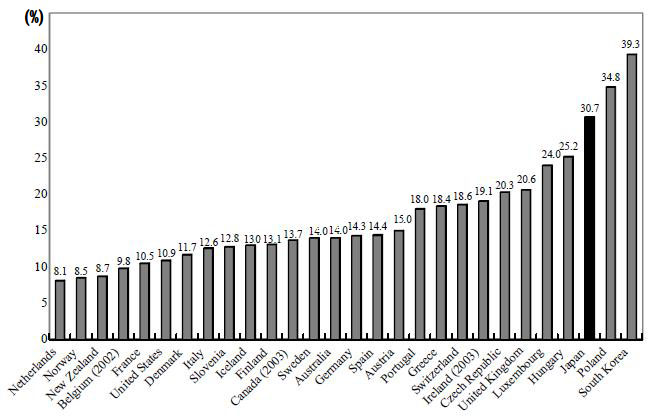
Note: 1. |
Source: IRTAD/OCED |
|---|---|
2. |
All figures are for 2004, unless otherwise specified in parentheses. |
3. |
All figures are based on the data of 30-day fatalities (number of persons who died within 30 days after an accident). |
<Encouraging citizens to improve their awareness>
| - | All citizens in this traffic society, including those engaged in traffic administration and transportation services, should become fully aware of the risk of traffic accidents, and remind themselves that they should endeavor not to cause and not to get involved in traffic accidents, with the ultimate objective of achieving a society with no traffic accidents. |
| - | To this end, further efforts should be made to enhance education and awarenessraising activities regarding traffic safety. However, these activities will bring about only a limited effect if they are focused merely on providing information or calling for attention to traffic safety in a unilateral way. It is vital for more citizens to foster positive attitudes to build a safe and secure traffic society by themselves. |
| - | Therefore, it is necessary to develop a mechanism that enables citizens to actively participate in creation of a safe and secure traffic society in local communities or organization by identifying traffic problems in the community, proposing concrete traffic related goals and policy, and actually carrying out various traffic safety activities. To help this, local governments should also strive to develop such a mechanism based on the specific circumstances in the respective areas. |
<Utilizing IT>
| - | With the rapid progress in information society, the use of information is important for building a safe and secure traffic society. Particularly, information technology (IT) is expected to significantly contribute to traffic safety, by supplementing shortcomings in people’s cognitive ability and judgment, counteracting people’s careless mistakes, and minimizing damage arising from such mistakes. |
| - | Among others, the government should drive forward the initiative to develop Intelligent Transport Systems (ITS) that would integrate people, roads and vehicles into a unified system with the use of IT. ITS will enable, for instance: (i) increasing traffic safety by providing information to compensate for a driver’s delay in finding objects on the road; (ii) improving the safety functions of vehicles such as crash prevention; (iii) upgrading traffic control; (iv) speeding up rescue and emergency services activities. |
(2) Measures to be taken
1) Improving the road traffic environment
While continuing the car-focused measures that have been successful to a certain extent, the government will, in response to the changing social situations such as the decreasing birth rate and increasing aged population, focus on protecting children and creating a traffic society where elderly people can go out safely and without anxiety, and plans to vigorously implement measures, in addition to the previously introduced ones, to provide people-oriented road traffic environment with safe and secure space to walk, by making enhanced efforts to develop walkways on school routes, community roads, and thoroughfares in urban areas.
| - | Providing people-oriented, safe and secure pedestrian space |
| - | Promoting the development of walkways for school routes, etc. |
| - | Developing “Safe Pedestrian Areas” and implementing traffic safety measures through the use of the “Manual for the Prevention of Traffic Accidents on Community Roads” |
| - | Developing barrier-free walkways and other measures for improving walk space |
| - | Improving road networks and promoting the use of high-standard highways |
| - | Achieving a safe and comfortable road traffic environment through the wide use of IT |
| - | Implementing comprehensive and intensive measures such as the development of “Road-for-Residents Zones” (zones where pedestrians and bicycles have priority) |
| - | Intensively implementing traffic safety measures through the Priority Identification Process |
| - | Promoting accident prevention measures for black spots |
| - | Pursuing safety measures based on scientific analysis by applying the “Traffic Accident Countermeasures and Assessment Manual” and the “Casebook of Traffic Accident Countermeasures” |
| - | Utilizing intelligent transport systems |
| - | Promoting measures against illegal parking under the new act |
| - | Developing tangible and intangible measures for the parking issue |
| - | Developing a disaster-resistant road traffic environment |
2) Comprehensively implementing traffic safety awareness initiatives
In light of the importance of inspiring individual citizens to realize that traffic safety is something to be achieved by their own efforts, the government will provide traffic safety education systematically and step by step for all generations from children to adults, as well as improve education designed for the elderly to improve their traffic safety awareness. In promoting traffic safety education and publicity activities, the government will actively promote citizens’ hands-on participation, direct experience and practical training. Furthermore, the government will also encourage community-wide activities through mutual assistance among related parties.
| - | Promoting traffic safety activities focused on citizens’ participation, hands-on experience and practical implementation |
| - | Promoting safety education for elderly people |
| - | Promoting safe bicycle riding |
| - | Promoting the use of seat belts by backseat passengers |
| - | Promoting the use of reflective materials |
| - | Promoting traffic safety initiatives by private organizations |
| - | Promoting citizens’ participation and collaboration |
3) Securing safe driving
The government will promote driver’s education, particularly elderly drivers, and improve comprehensive information services on road traffic by utilizing information technologies.
| - | Enhancing measures focused on elderly drivers |
| - | Promoting safe driving management |
| - | Improving the supervision of motor carrier businesses |
| - | Promoting the Trucking Business Safety Assessment Program |
| - | Promoting the use of video-recording drive recorders |
4) Ensuring vehicle safety
The government must evolve and mature the existing policies, which have worked well to reduce harm until now, and at the same time, further improve the vehicle safety measures for preventing accidents by utilizing advanced technologies.
| - | Developing and promoting advanced safe vehicles (ASV) |
| - | Improving Japanese Industrial Standards relating to vehicle safety |
| - | Improving motor vehicle check and maintenance |
| - | Improving and reinforcing the recall system |
5) Maintaining road traffic order
More accurate evaluation and analysis of traffic accidents and stricter traffic guidance and control will be promoted, focusing on the malicious, dangerous and annoying traffic violations that are most likely to cause fatal and serious accidents.
| - | Tightening traffic rule enforcement focusing on particularly vicious, dangerous, and annoying traffic offenses |
| - | Identifying the true locus of responsibility for the accident |
| - | Promoting guidance and enforcement concerning bicycle riders |
| - | Strengthening the investigation systems for traffic offenses and traffic accidents |
| - | Strengthening measures to crack down on motorcycle gangs |
6) Enhancing rescue and emergency services systems
The government will improve rescue and emergency services systems and emergency medical care services by promoting closer liaison and cooperation with emergency-related organizations. In particular, the government will promote the implementation of first aid procedures at emergency scenes.
| - | Promoting and educating first-aid measures including cardiopulmonary resuscitation with the use of an Automated External Defibrillator (AED) |
| - | Promoting the development and deployment of emergency life-saving technicians |
| - | Promoting the use of a doctor’s car |
| - | Improving Help systems for Emergency Life saving and Public safety (HELP) and developing Fast Emergency Vehicle Preemption Systems (FAST) |
| - | Promoting the doctor’s helicopter project |
7) Promoting victim support, including the appropriate compensation system
The government will comprehensively promote measures for traffic accident victims in a well planned manner under such acts as the Basic Act on Crime Victims, etc.
| - | Strengthening measures to help victims claim damages |
| - | Implementing measures with due consideration to victims’ feelings |
8) Enhancing R&D and study activities
The government will further implement research and development in relevant areas of three basic factors (people, roads, and vehicles), as well as to improve comprehensive study activities.
| - | Supporting safe driving |
| - | Promoting research on the traffic-related behavior of elderly people |
| - | Promoting R&D on the application of IC to license plates and seals |
| - | Enhancing comprehensive study to investigate the causes of traffic accidents |
Railway Traffic Safety
1. Achieving a Society with No Railway Accidents
A single accident can cause immense damage. The government will promote various safety policies and establish an unshakable trust in railway transport among the people.
(1) Current status of railway accidents
Although railway* accidents are on a decline in the long term, there have been operations accidents that have had significant social impact, such as the derailment of the East Japan Railway’s Joetsu Bullet Train caused by the Mid Niigata prefecture Earthquake in October 2004, the derailment of the Tosa Kuroshio Railway’s Sukumo Line in March 2005, the derailment of the JR West Fukuchiyama Line in April 2005, and the derailment of the JR East Uetsu Line in December 2005.
* Railway includes streetcar; hereinafter the same.
(2) Objectives set in the Fundamental Traffic Safety Program
The government will aim to bring the number of passenger deaths to zero and also reduce the number of operational accidents.
Changes in Railway Operations Accidents, Casualties, and Fatalities
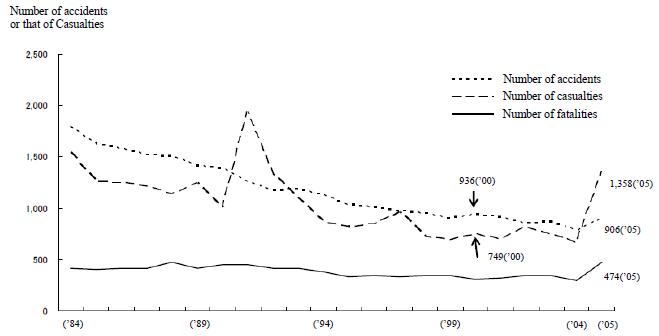
Notes: 1. |
Source: Ministry of Land, Infrastructure and Transport |
|---|---|
2. |
Fatalities are defined as people who died within 24 hours after an accident. |
2. Measures for Railway Traffic Safety
In addition to solving problems underlying individual accidents, the government will promote various traffic safety policies from a comprehensive viewpoint, utilizing the lessons learned from past accidents to take effective preventive measures.
1) Improving the railway traffic environment
| - | Improving operational safety systems (Installation of ATS and other devices to prevent speeding) |
| - | Reinforcing anti-earthquake measures for railways |
2) Securing safe railway operation
| - | Improving education for and quality of railway crews and safety personnel |
| - | Implementing safety audits for railway operators |
3) Ensuring railway vehicle safety
4) Enhancing rescue and emergency services systems
5) Promoting victim support
6) Enhancing R&D and study activities
Traffic Safety at Level Crossings
1. Achieving a Society with No Accidents at Railway Crossings
The government will aim for a society with no level crossing accidents by continuing to comprehensively and actively implement measures to prevent level crossing accidents.
(1) Current status of accidents at railway crossings
The long-term decline in the number of level crossing accidents is continuing.
(2) Objectives set in the Fundamental Traffic Safety Program
By 2010, the government will strive to reduce the number of accidents at level crossings by about 10% of the number in 2005.
Changes in Accidents at Level Crossings, Casualties and Fatalities
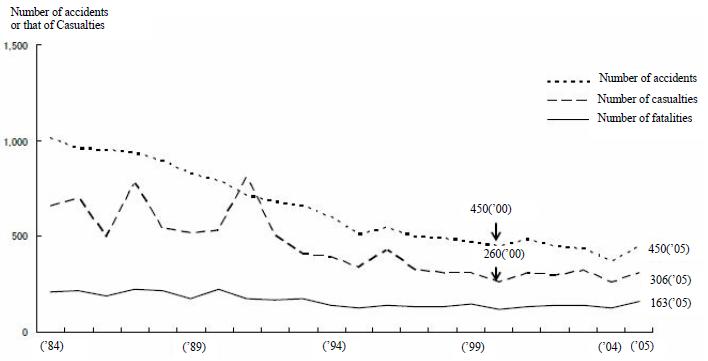
Notes: 1. |
Source: Ministry of Land, Infrastructure and Transport |
|---|---|
2. |
Fatalities are defined as people who died within 24 hours after an accident. |
2. Measures for Traffic Safety at Level Crossings
The government will comprehensively and actively implement more effective measures, in view of the conditions of each level crossing, such as measures for non-opening level crossings.
1) Promoting replacement of level crossings with grade-separated crossings, structural improvements, and improvement of grade separation facilities for pedestrians
| - | quick measures via structural improvements and drastic measures for grade separation at non-opening level crossings |
2) Improving level crossing maintenance facilities and implementing traffic restrictions
3) Promoting integration and elimination of level crossings
4) Implementing other measures to ensure safe and smooth traffic at level crossings
Maritime Traffic Safety
1. Achieving a Society with No Maritime Accidents
If a maritime accident occurs, it is likely to have an immeasurable impact on Japan’s economic activities and natural environment. Furthermore, it might also result in the loss of human life. Therefore, while placing the top priority on preventing the occurrence of maritime accidents, we should, in the event of an accident, carry out search and rescue operations promptly and properly to save the lives of people on board. Through such efforts, we should vigorously implement measures for maritime safety, aiming to achieve a society with no maritime accidents.
(1) Current status of maritime accidents
For the period from 2001 to 2005, the annual average number of vessels that needed rescue was 2,086, up by about 11% over the number for the previous five-year period, 1,877. On the other hand, for the same period, the annual average number of people who died or went missing in maritime accidents was 167, down by 2% from the number for the previous five-year period, 170.
The annual number of people who died or went missing because of falling overboard was 139, down by 16% from the number for the previous five-year period, 165.
(2) Objectives set in the Fundamental Traffic Safety Program
The primary objective is to prevent the occurrence of large-scale maritime accidents that would close waterways in congested waters, and reduce the number of such accidents to zero. The government will also strive to bring the annual number of deaths and missing persons caused by maritime accidents and from falling overboard to 220 or less by 2010.
Changes in Number of People Who Died or Went Missing from Falling Overboard
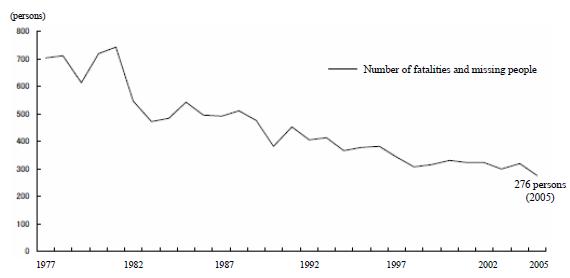
Note: 1. |
Source: Japan Coast Guard |
|---|---|
2. |
Figures for fatalities and missing people include those who, due to illness or other reasons, became unable to operate the vessel and died as it drifted. |
2. Measures for Maritime Traffic Safety
The government continues to promote various measures to prevent maritime accidents, and needs to vigorously implement more effective measures, including improvement and enhancement of the systems for prompt and proper lifesaving in coastal sea areas.
1) Improving the maritime traffic environment
| - | Developing the next-generation navigation support system that takes advantage of the automatic identification system (AIS) |
2) Disseminating knowledge on maritime safety
3) Securing safe vessel navigation
| - | Strengthening the supervision of passenger ship operators |
| - | |
| - | Drastically reforming the pilotage system |
4) Ensuring vessel safety
5) Enhancing safety measures for small vessels
| - | Developing boat parks and fisharina (facilities for pleasure boats established at fishing ports) |
| - | Implementing safety measures for fishing boats |
| - | Implementing safety measures for pleasure boats |
| - | Promoting the wearing of life jackets |
| - | Obtaining maritime accident information as early as possible |
6) Enforcing laws in maritime traffic
7) Enhancing rescue and emergency services activities
| - | Enhancing rescue and emergency services systems |
8) Promoting victim support
9) Enhancing R&D and study activities
Air Traffic Safety
1. Achieving a Society with No Air Traffic AccidentsIn order to reduce air traffic accidents and prevent safety problems that might cause accidents, the government will make constant efforts to implement measures for air traffic safety.
(1) Current status of air traffic accidentsThe number of aircraft accidents has been decreasing on a long-term basis. However, since January 2005, there have been notable safety problems due to human errors or mechanical problems.
(2) Objectives set in the Fundamental Traffic Safety ProgramThe government will strive to prevent the occurrence of air traffic accidents and continue to hold the record of no fatal accident caused by specified Japanese air carriers, which has been kept since 1986.
Changes in Air Traffic Accidents, Fatalities, and Injured Persons
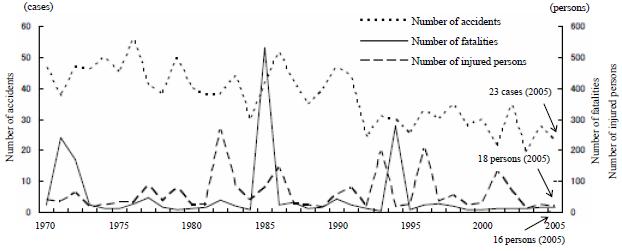
Note: 1. |
Source: Ministry of Land, Infrastructure and Transport |
|---|---|
2. |
All figures are as of the end of the given year |
3. |
Figures include accidents outside Japan involving Japanese aircrafts. |
4. |
Figures include accidents in Japan involving foreign aircrafts. |
5. |
Figures do not include natural deaths or non-accidental casualties (self-inflicted or inflicted by another person) that occurred on-board aircraft. |
6. |
Fatalities include all people who died within 30 days of the accident and those that went missing. |
7. |
Figures for Okinawa Prefecture were not included until 1971. |
It is an urgent issue to prevent the recurrence of non-fatal but serious safety problems, which can be regarded as seeds of large accidents, and restore the public confidence in air traffic safety. While making effort for increasing the airspace capacity, the government will strive to establish a safer and more efficient air traffic system.
1) Improving the air traffic environment
| - | Improving the New Air Navigation System |
| - | Enhancing air traffic services |
| - | Expanding airspace capacity and promoting the effective use of airspace |
| - | Strengthening disaster control measures for airports and aviation safety facilities |
2) Securing aircraft operational safety
| - | Strengthening the supervision over air carriers |
| - | Shifting the emphasis to prevention in traffic safety administration |
3) Ensuring aircraft safety
4) Enhancing rescue and emergency services systems
5) Promoting victim support
6) Enhancing R&D and study activities
Special Notes: Comprehensive Safety Measures Implemented by Public Transportation Operators
- In recent years, serious accidents and problems have frequently occurred in public transportation, such as the derailment of the JR West Fukuchiyama Line in April 2005, and a series problems in air transport caused by human errors or mechanical problems.
- Various factors are pointed out as the causes of human errors, e.g. the principle of safety first having turned into a mere shell, insufficient communication and information-sharing between the management sector and the operational sector as well as between the departments, and inadequate involvement of top management in safety initiatives. There is a pressing need to review the existing organizations and systems of public transportation operators and eliminate these problems, thereby restoring the public confidence in public transportation.
- In light of such circumstances, the government will implement the following cross-sectoral measures in addition to safety measures for the individual fields of transportation, i.e. automobile, railway, vessel, and aircraft.
| - | Requiring transportation operators to develop Safety Management Manuals and appoint Safety General Managers as compulsory obligations |
| - | Encouraging transportation operators to build a safety management system that involves every level of operator, from top management to the operational sector, and introducing Evaluation of Transport Safety Management Posture by which the government will evaluate safety management postures at management level |
| - | Promoting the development of technology to help persons operating public transportation to notice any hazardous conditions |
| - | Promoting the development of technology to enable operation managers to understand the status of operation and provide appropriate support |
